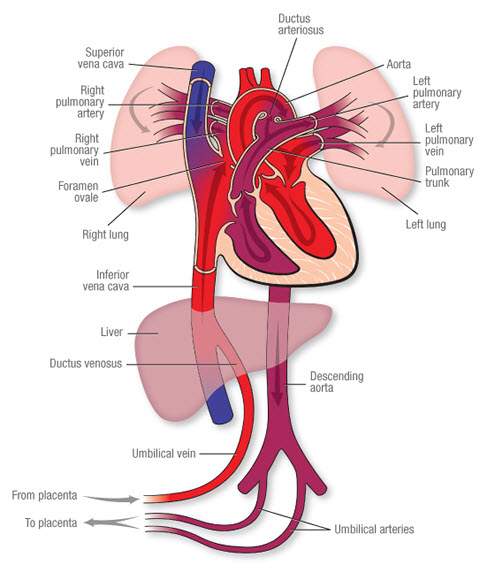Fetal Circulation

Blood flow through the fetus is actually more complicated than after the baby is born (normal heart). That’s because in the mother, the placenta is doing the work that the baby’s lungs will do after birth. The placenta also functions as the gastrointestinal tract, liver and kidneys for the growing fetus.
Oxygenated, nutrient-rich blood from the placenta is carried to the fetus by the umbilical vein. This blood enters through the inferior vena cava (the large vein that carries blood from the lower and middle body into the right atrium of the fetal heart). After oxygenated blood arrives at the right atrium, it flows through the foramen ovale (an opening between the right and left atrium) to the left ventricle, then into the aorta (the main vessel, which carries blood from the heart to the rest of the body and the brain).
Some blood from the aorta flows to the two umbilical arteries and re-enters the placenta, where carbon dioxide and other waste products from the fetus are taken up and enter the maternal circulation. The placenta accepts the blood without oxygen from the fetus through the umbilical arteries. In the placenta the blood picks up oxygen and returns to the fetus via a third vessel in the umbilical cord (umbilical vein). The oxygen-rich blood that enters the fetus passes through the fetal liver and enters the right side of the heart.
Blood coming back from the fetus also enters the right atrium through the superior vena cava and coronary arteries. This doesn’t shunt through the foramen ovale, but the fetus is able to send this oxygen-poor blood from the right atrium to the right ventricle (the chamber that normally pumps blood to the lungs). Most of the blood that leaves the right ventricle in the fetus bypasses the lungs through the second of the two extra fetal connections, known as the ductus arteriosus.
The ductus arteriosus sends the oxygen-poor blood to the organs in the lower half of the fetal body. This allows for the oxygen-poor blood to leave the fetus through the umbilical arteries and get back to the placenta to pick up oxygen.
Since the foramen ovale and ductus arteriosus are normal findings in the fetus, it is impossible to predict whether these connections will close normally after birth in a normal fetal heart. These two bypass pathways in the fetal circulation make it possible for most fetuses to survive pregnancy even when there are complex heart problems and not be affected until after birth, when these pathways begin to close.





